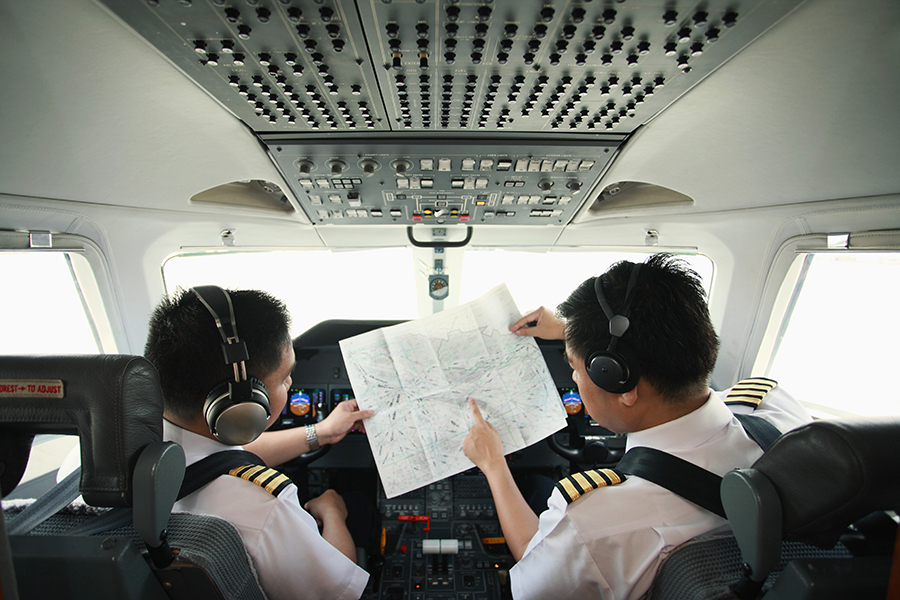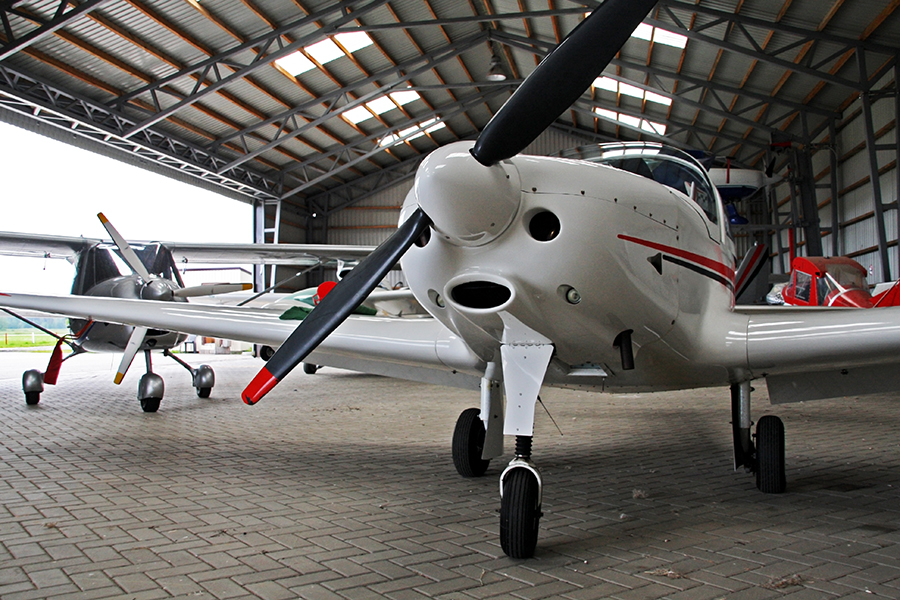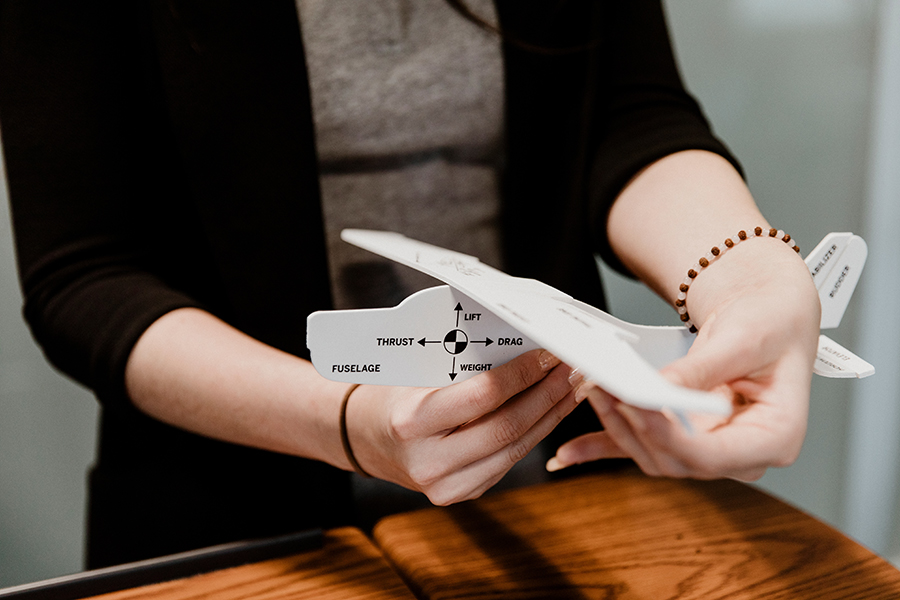-
What is a Diversion in Aviation?
-
Potential Reasons to Divert Your Aircraft
- Weather
- Airport Closure
- Pilot Preference
- Airplane Performance
- Fuel Requirements
-
The Diversion for Private Pilots - A Step-by-Step Guide
- 1) Keep the Aircraft Safe
- 2) Get the Weather for Your Diversion Destination
- 3) Plot Your Route
- 4) Measure Your Distances
- 5) Work Out Timings
- 6) Make Notes!
- 7) Consider Fuel Endurance
- 8) Reset Your Heading Indicator
- 9) Turn, Time, Orientation
- 10) Brief Yourself for the Arrival on the Way
-
Private Pilot Top Tips
- Fly the Aircraft!
- Set off from a Known Point
- Start Your Stopwatch!
- Use Big Fixes
- Draw A Nice Big Wind Arrow
- DON'T Forget Variation
- Consider a Mayday
- If in Doubt, a 180 Works
- Close Your Flight Plan!
- Practice Diverting!
-
Final Thoughts
While it’s not ideal, we can’t always get to where we want to go. Aviation is dynamic, and plans change, sometimes in the air, also known as diversions! Private pilots carry out diversions all the time, and in this guide, we’ll show you how to do it, along with some expert tips on things to consider to ensure success.
Here’s what you need to know.
What is a Diversion in Aviation?
A diversion is when the aircraft is successfully navigated to a different point than its originally intended destination. Diversions are unplanned events that can occur at any stage during a flight for various reasons. It is a skill that all private pilots should learn.
Want the good news?
Planning and executing a diversion doesn’t have to be a challenge. While there initially might be an element of the unknown, with the right general technique, and a good sense of airmanship, diverting should be safer than continuing on to your original destination.
Below you’ll find a great guide on the general outline of diversions for private pilots. We’ll also give some key tips you must remember if you want to get from A to B, and even to C, safely.
Potential Reasons to Divert Your Aircraft
Before we go into the ‘how’ of diverting as a private pilot, it is important to consider why a diversion might be necessary. Here are the main reasons why private pilots have to know how to plan a diversion: –
Weather
As the pilot of a light aircraft, you will always need to keep an eye on the weather. This is especially true if you are limited to VFR flying.
For pilots flying longer routes, the weather can change over time to be quite different than what you were expecting. While it could have been a glorious day at your destination when you departed, the conditions may prohibit a landing at your destination. Any of the following could be a good reason to consider a diversion
- Wind limits
- Visibility
- Cloud base
- Heavy precipitation
- Windshear
- Thunderstorms
Or any combination of the above!
Airport Closure
While rare, occasionally, airports do close unexpectedly. The reasons are varied, but if your choice of destination airport becomes available. At the same time, you are airborne, and you need an effective strategy to be able to head elsewhere.
Pilot Preference
One of the joys of flying a light aircraft is that you can go wherever you want. Sometimes you may elect to change your mind when airborne and plan a route to a new place.
Airplane Performance
There may be a situation where much as you want to go to your destination, the airplane performance will prevent it.
Part of being a good pilot is planning ahead.
And get this…
It isn’t just about if you can land. It’s also about if you can take off again!
Let’s say you land at an airfield in the morning and intend to depart again in the afternoon. What will you do if the temperature rises and affects your estimated takeoff run? If you haven’t got enough takeoff distance to accommodate your airplane performance, guess what?
Yep, you’ll be stuck there for the day.
Want the easy solution?
Plan an en-route diversion!
Fuel Requirements
The wind aloft is just as important to pilots as the wind around the runway.
While aviation weather forecasts are pretty accurate, occasionally, they can be wrong.
If you are making your way to a distant airfield and the wind isn’t in your favor, you may find that you don’t have the fuel to make it all the way.
In this case, the only option will be to divert.
The above list isn’t exhaustive.
Here’s the truth.
As a private pilot, you can elect to divert for any reason. Here’s our full guide to diversions for private pilots.
The Diversion for Private Pilots – A Step-by-Step Guide
All of the below points are vital in planning a successful diversion. With time, patience, and practice, you’ll be a dab hand at diverting in no time.
This is what you must know: –
1) Keep the Aircraft Safe
We’ve included this for a reason. Often a diversion is unexpected, and it can be unsettling.
Remember the following, as a pilot, it is your job to: –
- Aviate
- Navigate
- Communicate
In that order!
It’s no good having your head down and creating a work of art on your chart, only to look up and realize you have no idea where you are!
Good pilots will keep the aircraft safe at all times. Fly first, plan second. Try and keep good situational awareness. Consider what is around you and only plan your diversion once you can be 100% sure that the aircraft is safe.
2) Get the Weather for Your Diversion Destination
Your first task should be to determine if where you plan to divert is suitable.
Let’s face it…
There is no point flying for half an hour only to arrive at your diversion airfield to find the weather precludes a successful landing!
Before you put pen to paper or set off in a given direction, get the weather. There are a few ways you can acquire this information: –
- Look at the TAFS
- Contact Air Traffic Control
- Listen to an ATIS
- Ask a Fellow Pilot (PIREP)
- Utilizing a Flight Information Service (FIS)
There is a detailed guide to aviation weather services provided by the FAA. You can see it here.
3) Plot Your Route
Once you know where you want to go, it’s time to decide how you plan to get there.
Pilots don’t guess. It’s time to draw a line on a map.
Generally, you will want to keep it simple. Try to keep your waypoints to a small number. Ideally, you want a single line running from your chosen starting point to your diversion airfield.
However.
It’s not just as simple as drawing a line. There are a few things you will definitely need to consider. Once you have a provisional route drawn, be sure to consider the following: –
- Airspace – Can you fly to your destination without any ‘busts’.
- Terrain – What is the en-route minimum safe altitude? (MSA)
- Emergency Landing Sites – This is important for single-engine aircraft especially. Does the terrain you plan to fly over allow for precautionary or emergency landings?
- Ease of Navigation – Are there a few easy-to-see navigational fixes to keep you on the right track
- Navigational Aids – Any route that features a few radio-based navigation aids can be useful to check your progress.
Generally, good airmanship applies just as much when diverting as it does from routing from point A to point B.
Once you have a line on your map, you can measure the heading to fly using a navigational plotter.
4) Measure Your Distances
Knowing how far you have to fly is vital in planning a diversion.
Now.
There are two ways you can do this. And both work really well.
The first method is to use a chart plotter or aviation ruler. Simply measure along your line to work out the distance.
However.
This takes time and can be quite cumbersome while controlling an aircraft.
So, here’s an easier way.
You’ve heard of the ‘rule of thumb’, right?
As a good ‘on the fly method, use the end joint of your thumb to work out a rough distance.
On US sectional charts, the scale is normally 1:500,000. In simple terms? Each ‘thumb’ along your route equals (roughly) 8 statute miles.
4 thumb lengths? Easy, that will be about 32 miles to fly!
Try it at home on your chart and see how accurate it is!
5) Work Out Timings
Once you know the distance, you need to know how long it should take you to get to your diversion.
The simple formula is distance divided by speed.
You already have the distance from our previous calculation, and you’ll already have a good idea of your true airspeed. All you need to do is plug in the numbers!
6) Make Notes!
There is quite a lot to consider when planning a diversion, and things are easily missed or forgotten.
Your best bet is to jot down the following as soon as you know it: –
- The required heading to diversion airport (in degrees magnetic)
- The altitude to fly
- The distance to your diversion airfield
- The time it will take to get there
7) Consider Fuel Endurance
As diversions are often unplanned, fuel monitoring can often be neglected.
Don’t be that guy.
Before setting the course to any alternative airfield, be sure to check your fuel quantity and make a reasonable estimate of your remaining endurance.
You can normally find fuel consumption tables in your airplane flight manual.
8) Reset Your Heading Indicator
While planning a diversion, private pilots can sometimes miss the bigger things.
And we need to tell you…
Setting off on a heading when your heading indicator is not correctly aligned can lead to gross navigational errors. Make sure your flight instruments will provide you with valid data.
9) Turn, Time, Orientation
You’ll hear all sorts of techniques and methods used advising how to set off on a diversion.
Want something easy to remember?
Here’s a simple two-part acronym for general navigation and diversion initiation.
Remember “HAT” and “TTO”
Here’s a breakdown.
“HAT” – Before setting course – announce to yourself the required:
- H – Heading
- A – Altitude
- T – Time to fly on the heading
It’s then time to get the aircraft going in the right direction. And for that, we use…
“TTO” – Do this at every fix or when starting your diversion
- Time – Start your stopwatch
- Turn – Turn onto the required heading
- Orient Yourself – Use features outside the aircraft as a good gross error check.
Wait, a gross error check?
Yes, as diversion initiation is sometimes time critical, you must perform a perfunctory check to see if your navigation is starting out successfully.
Want an example?
Use a big feature like a large lake, town, road, or anything else that is easy to see from the air. Suppose it is in the same position relative to your aircraft as it is to the diversion line on your map. In that case, there’s an excellent chance you are headed in the right direction.
10) Brief Yourself for the Arrival on the Way
Normally you won’t have planned to land at your diversion airport in advance, and there might be quite a few differences compared to your original destination.
While it is vital to maintain accurate navigational awareness, the cruise phase of your flight can also be put to good use in other ways.
Such as?
Why not take a few minutes while you are straight and level to familiarize yourself with your new destination and “self-brief” your arrival and what you can expect when you get there?
Private Pilot Top Tips
While the above covers how to plan a diversion, private pilots can even go further and apply a little ‘polish’ to their performance. Here are some tips to ensure that flying to a diversion is successful.
Fly the Aircraft!
Obvious?
Perhaps, but you’d be amazed how many pilots start neglecting the basics when they become unsettled.
Remember, as the pilot, you are in charge of where the airplane goes. Flying the aircraft, even if just keeping it straight and level, should take priority over any ‘theoretical’ diversion planning and course-plotting.
Set off from a Known Point
The easiest way to determine where you are going is to measure accurately from a given point.
This is never more important than when planning a diversion.
Chances are there will be a prominent feature nearby that is easy to identify and obvious on the map.
Why not make life easy and start your diversion from there instead of a featureless and arbitrary point on a map?
Start Your Stopwatch!
This is a big one.
We (may) have learned this through experience.
Ahem.
You get to set up to make your diversion, discovering that you forgot to start your stopwatch overhead your initial fix. Now you don’t know how far along your route you are.
Want an easy fix to ensure this never happens?
Ensure you do a HAT-TTO check as described in our diversion guide above.
Use Big Fixes
An element of diversion flying is navigating “on the hoof”.
Here at simple flying, we like to make things easy.
Choose a route with some prominent and easy-to-spot fixes when planning a diversion.
Aside from making navigating your aircraft easier, it sure is reassuring when you can see that your track is working out miles in advance.
Draw A Nice Big Wind Arrow
You may notice that our above guide didn’t include a wind correction.
Unlike in the flight planning room, there simply isn’t time to add detailed wind corrections when performing an airborne diversion.
Want a simple solution?
Draw a nice large wind arrow on your chart, showing you where the wind is coming from. You can make a really quick estimate of your required heading correction using a quick crosswind calculation.
You can find more out about this technique right here.
DON’T Forget Variation
It is vital to remember that your aircraft heading indicator gives degrees magnetic. Your map (where you have drawn your course) references headings in degrees true. You have to add or subtract variation if you want to fly an accurate course.
Haven’t you got to grips with the difference between true and magnetic heading yet? Why not start now?
Consider a Mayday
Diversions can come unexpectedly, and even commercial pilots find them a little perturbing.
There is no shame in asking for help from air traffic control. Often a mayday, or a “PAN” call, can be really beneficial. Air traffic controllers are well trained in providing headings and assistance to aircraft unsure of their position. This is more likely to happen on a diversion.
So.
If you do get lost, don’t be afraid to speak up!
If in Doubt, a 180 Works
Generally, the simplest solutions in aviation often prove to be the most effective.
Suppose you are struggling or think you might have made an error in your diversion planning. In that case, there is a guaranteed way to ensure you get back to familiarity.
A 180ۧ° turn!
Provided you have flown accurate headings, you can simply return to your start point, figure out where you went wrong, and try again.
Close Your Flight Plan!
After a diversion, private pilots aren’t normally in the place where they declared they’d be on their flight plan.
The bad news?
The people at your original destination will, in all likelihood, still be expecting your arrival.
And by “people”, we mean ATC.
If you fail to turn up, there is a very real possibility that they will initiate a search and rescue operation. While they will be relieved that you are safe, they probably won’t see the funny side.
The simple solution?
When you land, be sure to call ATC and close out your flight plan!
Practice Diverting!
Do you know the best way to get good at any skill?
Practice and lots of it!
Diverting is not something you ideally want to be trying for the first time when it really counts.
Luckily, there is another way.
Why not practice diverting when you have time and fuel on your hands? The ideal time to give it a go is when navigating on a clear day. It’s even more effective if you can see where you intend to divert. Pretend you can’t see the alternate, plan a diversion route while airborne, and see if your navigation works out.
With luck and skill, it will; if not, you’ll be able to work out what went wrong pressure-free.
Final Thoughts
While somewhat unsettling, it is important to remember that, normally, diverting is the safer course of action. Fly the airplane, be meticulous in planning, and practice for ultimate success in diversions. Private pilots can get lots of great tuition, even at home. Want proof? Take a look at our free flying courses, all online!



